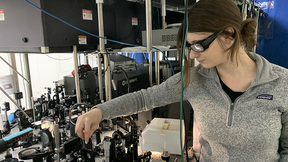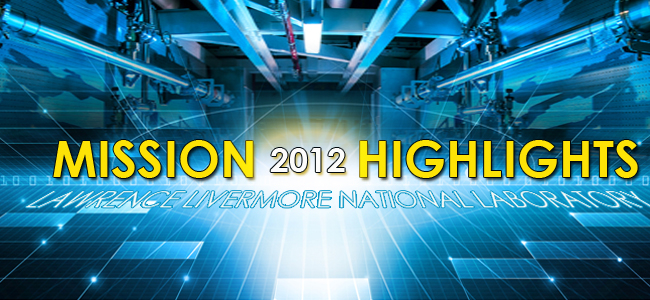2012 mission highlights continue Lawrence Livermore National Laboratory's long tradition of service to the nation
Lawrence Livermore National Laboratory (LLNL) continued its long tradition of applying innovative science and technology to strengthen the nation's security in 2012.
The Laboratory further developed science and technology capabilities essential to fulfilling its principal missions of sustaining the nation's aging nuclear deterrent without nuclear testing and countering nuclear proliferation and terrorism. 2012 marked the 20th year since the United States ceased nuclear testing. In addition, LLNL continued to apply cutting-edge scientific and technical expertise to defense and international security areas such as advanced conventional munitions, biosecurity, cybersecurity, space situational awareness, directed energy weapons, and enhanced protection of soldiers.
Lawrence Livermore's unique expertise also is contributing to the nation's energy and environmental security and is sharing it with U.S. industry to boost the nation's economic competitiveness.
This list of 10 top mission accomplishments -- which complements the 10 top science and technology stories -- is indicative of the broad mission responsibilities and the capabilities the Laboratory brings to bear on important national problems. These represent only a sampling of mission-directed research stories during the 2012 calendar year. See the LLNL FY 2012 Annual Report for more information about the Laboratory's accomplishments.
- Extending the service life of the W78 warhead: In July, LLNL and the U.S. Air Force launched a detailed design study to extend the life of the W78 Minuteman III intercontinental ballistic missile warhead. A key component of the nation's nuclear deterrent, the W78 system has aged beyond its planned service life. In addition to addressing aging concerns, LLNL weapons experts are evaluating options to incorporate enhanced safety and security features, examining methods for reducing production costs, and studying the adaptability of the warhead for Navy deployment. Read more on the S&TR Website.
- Pushing the boundaries of high performance computing: The Laboratory deployed the Sequoia supercomputer (see Top 10 Science Stories), a 20 petaflops (20 quadrillion floating point operations per second) IBM BlueGene/Q system, which will be dedicated to the effort to ensure the safety, security and reliability of the nation's nuclear deterrent when the system transitions to classified work in March this year. Sequoia's mammoth computational power will be used to assess physical weapons systems using advanced uncertainty quantification techniques and provide a more accurate atomic-level understanding of the behavior of materials in the extreme conditions present in a nuclear weapon. In June, Sequoia was ranked No. 1 on the industry standard Top500 list of the world's fastest supercomputers, dropping to No. 2 in November. Read more on the LLNL news article.
LLNL took the lead for the National Nuclear Security Administration (NNSA) and the Department of Energy (DOE) Office of Science in managing the FastForward Program to push high-performance computing (HPC) technologies toward the technically challenging goal of exascale (1,000-petaflops) computing.
- Plutonium aging gracefully: LLNL's continuing studies of plutonium aging show that no unexpected aging issues are appearing in plutonium that has been accelerated to an equivalent of approximately 150 years of age. These results are highly positive for the safety and reliability of the stockpile and for avoiding the costs associated with remanufacturing pits. They are consistent and reinforce plans to pursue a limited pit manufacturing capability to support life extensions of the stockpile to ensure the effectiveness, safety and security of the deterrent, and to guard against technological surprise. Read more on the S&TR Website and LLNL news article.
- Groundbreaking science experiments at the National Ignition Facility (NIF): During fiscal year 2012, NIF conducted a total of 332 high-energy-density science experiments. NIF is the nation's premiere facility for stockpile stewardship and the only facility in the world with the potential to duplicate many of the phenomena and physics that occur in the heart of a modern nuclear device. To date, nearly 200 highly successful experiments have been conducted to characterize the properties of materials at extreme temperatures and pressures in support of the nation's Stockpile Stewardship Program. These experiments are benefiting from NIF's exceptional performance. In addition, fundamental science and ignition research experiments were conducted at NIF. One series of science experiments characterized carbon at nearly 50 million times the Earth's atmospheric pressure. The researchers' interest is the formation and structure of large planets, such as Jupiter and Saturn. Read more on the LLNL news article.
- 100th JASPER experiment: In September, LLNL's JASPER (Joint Actinide Shock Physics Experimental Research) gas gun fired its 100th shot. The experiments have collected data that enable weapon scientists to understand important properties and behaviors of plutonium and other special nuclear materials shocked to extreme conditions. Located at the Nevada National Security Site (formerly the Nevada Test Site), JASPER is an important scientific tool in NNSA's Stockpile Stewardship Program to sustain the nation's nuclear deterrent without conducting underground nuclear tests. Read more on the LLNL news article.
- Lab directors meeting in Russia: U.S. and Russian laboratory directors and representatives from NNSA and Rosatom held a meeting in Sarov, Russia, in June 2012. The meeting and associated tours of five Rosatom laboratories provided an opportunity to establish a path forward for scientific and technical cooperation -- a U.S. government goal -- between the laboratories in basic science and technology, international security, energy research and other areas of mutual interest. Read more on the LLNL news article.
- Treaty verification and monitoring: LLNL led the modeling and data analysis for the Pele test, conducted to assess the ability of various technologies to distinguish the signatures for weapon development from other activities. The results of the test campaign will help determine which techniques can be used for effective treaty verification and monitoring. This work complemented other nuclear nonproliferation efforts, including the development of new plastic materials for effective identification of uranium and plutonium by detectors used in ports, stadiums, and other such facilities. Read more on the LLNL news article.
- Tracking space debris: Launched in September 2012, a "nano-satellite" called STARE (Space-Based Telescopes for Actionable Refinement of Ephemeris) contained an LLNL-designed optical system for tracking pieces of space debris with a precision 10 times greater than currently possible. Telescopes, cameras, altitude control, data transmission, power and GPS were packaged into a 10-by 30-centimeter space. STARE can reduce the number of false alarm rates for potential collisions of debris with U.S. space assets by a factor of 100. Read more on the S&TR Website.
- High-performance computing energy collaborations: With a mission to enhance U.S. energy security, the Laboratory entered into a project with the California Energy Commission to leverage LLNL's high-performance computing (HPC) capabilities and high-resolution weather models to improve the forecasting of solar and wind power generation and to address challenges involved in integrating intermittent renewable energy sources into the state's energy grid. LLNL also launched the "hpc4energy incubator," a pilot program that teams six energy-industry companies with the Laboratory's scientific and HPC resources to find solutions to pressing energy-related problems of mutual interest and accelerate the development of energy technologies. At a workshop in November, company representatives highlighted how application of HPC is showing them exciting ways "to think differently about problems." Read more on the LLNL news article.
- Deinventory of high-security special nuclear materials: In September, the last of the special nuclear material items that require the highest level of protection were removed from the Livermore site. Through the concerted effort of Laboratory personnel, deinventory of these items was completed two years ahead of the original schedule. LLNL security has made the transition from Security Category I/II operations to Category III operations that are appropriate for the small quantity of special nuclear material that remains on site, reducing costs by about $40 million per year. Read more in the NNSA press release.
Contact
Donald B Johnston[email protected]
925-423-4902
Related Links
LLNL FY 2012 Annual ReportS&TR: Extending the Life of an Aging Weapon
NNSA's Sequoia supercomputer ranked as world's fastest
S&TR: Plutonium at 150 Years
LLNL: Plutonium at 150 years
National Ignition Facility makes history with record 500 terawatt shot
100th shot for LLNL's 'gun in the desert'
LLNL, LANL, Sandia directors visit Russian laboratories
Lawrence Livermore National Laboratory's top 10 science stories of 2012
S&TR: Launching Traffic Cameras into Space
Lawrence Livermore teams with industry to advance energy technologies using high performance computing
NNSA Completes Removal of All High Security Special Nuclear Material from LLNL
Tags
ScienceFeatured Articles








